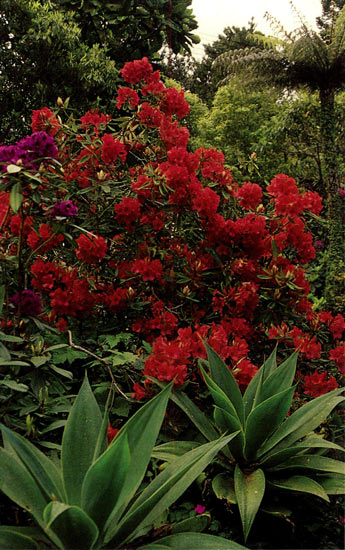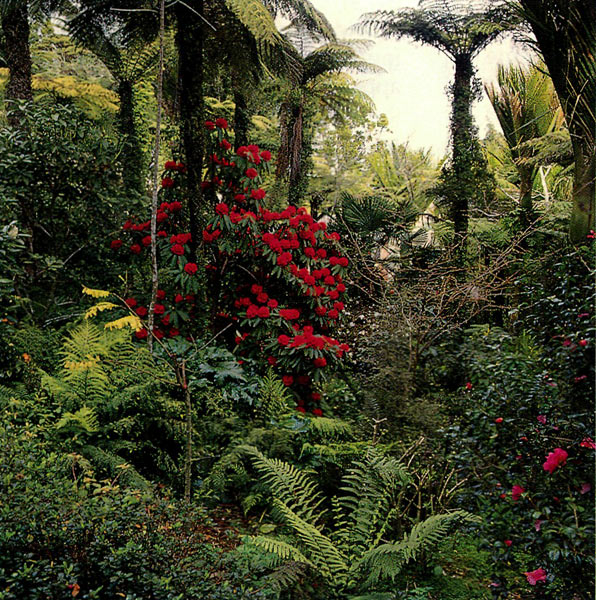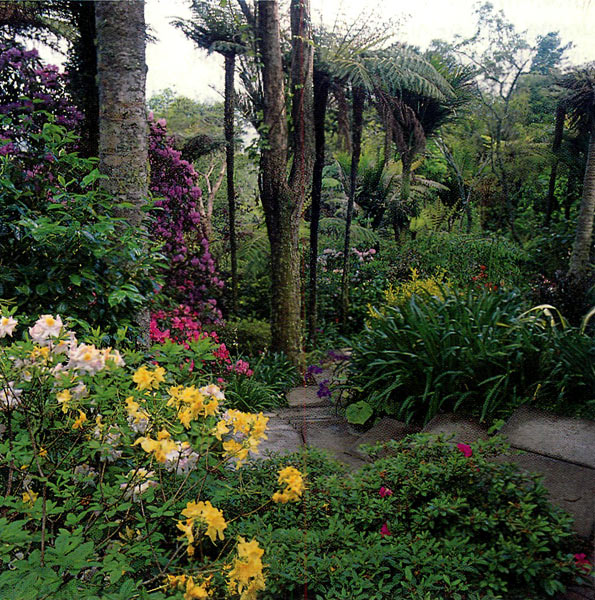JARS 49n4 - New Companions - Or Just Old Friends
New Companions - Or Just Old Friends
Geoffrey H. Haughey
Auckland, New Zealand
We have a visitor from Philadelphia to thank. "Do you know," she said after strolling through our garden, "there are only two plants here that I can grow - rhododendrons and the Japanese anenomes." How frequently it is only the outsider's objectivity that enables us to see the uniqueness of what we take for granted - one of the many benefits of opening the garden to the public!
From a hemisphere away, New Zealand is inevitably perceived as a small country (which it is) with a consequently homogeneous gardening environment (which it is not). The reality is a land of enormously diverse terrain and climate stretched over one thousand miles between latitudes 34 and 48 South. Between the geographical extremities of North Cape and Bluff, rhododendron enthusiasts abound, and a visitor's overview has been well described by Kenneth Cox in his article "Rhododendrons in New Zealand" in the Journal (Vol. 47, No. 4, Fall 1993). Just south of Auckland, around latitude 37 South, there is a low range known as the Bombay Hills. Of no great geographic consequence themselves, they nevertheless symbolize a climatic and social divide of considerable significance. To the south, rhododendron lovers garden in the time honoured traditions imported as part of our British colonial heritage and honed by North American responses to a continental climate. In an environment benign by comparison with those origins, the tried and true plant associations of northern hemisphere gardens flourish. Overhead there are the generous plantings of deciduous trees and beneath, luxuriant spring to fall displays of bulbs and perennials. The winter scene could equally have been lifted directly from the other side of the world. Often the only complaint is that the cold is not severe enough to ensure the adequate devastation of the bug population or for the plants to understand the appropriate time to resume growth.
North of Bombay Hills is a whole new world. Here, nature and nurture have provided the opportunity for a completely different landscaping imperative. While wet, the winters are mild, many areas never even experiencing frost. In any area with a little altitude or near the coast, overnight ground temperatures never fall below 3-5°C (37-41°F). Summers are drier though irregular downpours are not unknown, and the temperatures are warm but never searing. Only once in a decade do the mid-afternoon readings ever hit 30°C (86°F), mid twenties being the norm.
When choosing rhododendron companions in this temperate cum subtropical environment, the demands bear little relation to colder climate gardening. Many of the classics either don't grow or struggle and look dreadful. And the social climate is different. Which sailing ship your colonial ancestors arrived on is an irrelevancy, and Polynesian and Asian influences are noticeable.
As a result, one's approach to landscaping can be driven more by potentials and possibilities and less by shalls and should-bes. So what does a rhododendron lover's landscape look like? Let me limit my descriptions and illustrations to Westridge, our own half acre on the outskirts of Auckland city.
Firstly, what you won't find! No rambling roses, no pastel perennials, not a buxus or lavender hedge to be seen, and little in the way of manmade ornamentation. Rather, pride of place among the rhododendrons is given to this country's own unique vegetation, amongst which are a host of plants that create a bold-foliaged, sub-tropical theme. Why is it that gardeners everywhere ignore what nature bequeaths us while we struggle with imported fads and fashions? But don't be put off by this exhortation. Most "down under" plants thrive along the Pacific Coast of North America if the microclimate is appropriate.
Two plants immediately strike the visitor as they dominate the canopy - the tree fern or ponga 1 ( Cyathea dealbata ) and the native palm, the nikau 1 ( Rhopalostylis sapida ). These not only provide the perfect filter between our under-planting and the large ozone hole above, but also their leaf fall provides a continuous supply of very slowly decomposing mulch material which enables the fine rhododendron root mats to thrive above our sticky clay soil. What the maple leaf is to Canada, so is the ponga frond to New Zealand - the quintessential national plant symbol and one worn with pride by all sports people abroad. Our gardeners, however, are generally less enamoured of this particular emblem, for while it is not difficult to grow, it is under used in landscaping. Nevertheless, New Zealand is probably the only place in the world where you can experience the dramatic combination of primary coloured rhododendrons flowering among lush palms and feathery ferns with not an abies or an acer in sight. Well almost - we are not that doctrinaire.
For the spiky look in foliage the choice is also large. Some of our ponga are covered with symbiotic kiekie 1 ( Freycinetia banksii ), a scrambling rain forest climber with a droopy grass-like look. This is an aggressive grower and does need to be kept under control. Many locals would probably regard it as a totally inappropriate garden plant, but it sure adds to the rain forest look. Equally dramatic and popular internationally is the ti kouka 1 or cabbage tree ( Cordyline australis ), so named for its edible rather than visual qualities. This very architectural plant is endemic in the New Zealand countryside, holding a place deep in the national psyche and being planted formally in the forecourt of our Parliament. But like the ponga it is somewhat disregarded by gardeners. While a lot of hybridizing has produced numerous coloured forms that are more popular, we have been happy to let the original species self sow amongst the rhododendrons. You could hardly juxtapose two more contrasting plant forms.
While the ponga, nikau, kiekie and ti kouka do grow further to the south, other frost tender species are particularly distinctive features of northern gardens. The puka 1 ( Meryta sinclairii ) is one of our dramatic background trees with dinner plate-sized flat glossy leathery leaves of bright lime green. And as an uplifting complement to dull evergreen winters, nothing beats the variegated form of parapara 1 ( Pisonia brunoniana 'Variegata'). The splash of cream is the perfect foil for the primary rhododendron reds, and we have planted Rhododendron 'Ivery's Scarlet' and R. 'Taurus' in association with this stunner. Later in the season a more subtle colour scheme features as R. 'Lemon Lodge', New Zealand's best ever soft limey-lemon hybrid, puts on its consistent display. The cats love the parapara for all the wrong reasons. No accident that the common name is the bird catcher tree, as its sticky seed pods snare hapless prey unless we get out with secateurs and cut off the blooms.

|
|
Early summer: an antipodean Christmas is
celebrated not with holly but the last of R. 'Thor' in the company of the striking foliage and flowers of Strelitzia regime . Photo by Geoffrey H. Haughey |
More recent arrivals are building on the established native nikau palm canopy. Our one maturing Chinese windmill palm ( Trachycarpus fortunei ) is up three metres with dramatic fan shaped leaves, so this foliage theme has been followed with some Australian fan palms ( Livistona australis ). These are slow growers so it is fortunate we have the patience that comes from growing rhododendrons. For complete contrast, in a dry sunny spot we have planted a bluey green drooping curved-leafed jelly palm ( Butia capitata ) from southern Brazil and Uruguay. And in the darker, damper under storey areas there has been room for two Central American natives, the parlor palm ( Chamaedorea elegans ) and the cluster palm ( Chamaedorea seifrizii ). It would, however, be arguable to say that few rhododendron growers would ever have considered the palm family as compatible with their first love.
It has been in the choice of low level companions that the sub-tropical world beyond these shores has really been our oyster. But there is an indigenous fern that has been particularly successful. Commonly known as the hen and chicken fern ( Asplenium bulbiferum ) because of its interesting reproduction habits, this is a closeted house plant further south that thrives beneath our rhododendrons, the feathery spreading fans forming dense clumps that buck no competition from weeds.
Weeds are a real issue in this benign environment, as growth can be rapid, invasive and quite quickly destructive. We don't know whether to laugh or cry when visiting the great heated greenhouses of famed northern hemisphere gardens, only to see many of our worst enemies being tended with care! One of my most favoured subtropical weed controllers is the aluminum plant, Pilea cadierei . This forms wonderful dense clumps beneath the rhododendrons, and the silver highlighted leaves give a great lift to dark corners. And we have had equal success with Chlorophytum comosum , likewise with another ground cover that many locals sneer at, Plectranthus ciliatus . This forms a dense but very easily managed foliage underplant that brings the whole garden alight in late summer when smothered with mauve-white starry flower sprays.
For all year round foliar foils to the evergreens, there are a few distinctively coloured sub-tropicals I am particularly partial to. Deep purple-black is provided by Strobilanthes anisophyllus . This provides the added bonus of contrasting form, being feathery, almost fern-like, in appearance. It grows in the shade but the more sun it gets the richer the colour, and it obviously enjoys our conditions as it readily seeds itself. Greys are also great, and if you are happy to replicate fluffy Sissinghurstesque orthodoxies not too much of a challenge when selecting plants. But the choice for the sub-tropical gardener is somewhat more limited. Recently, however, I discovered Plectranthus argentatus , a wonderful bold-leafed frost sensitive plant that will grow to a couple of metres. For contrast in form we have a great New Zealand plant family, the spiky astelias, of which there are some very striking silver hybrids. For bright red, the classic colour wheel complement to green, Iresine lindenii is ideal. The annual clip back needs a little care about timing to ensure spring growth rather than a winter loss, but the prunings root easily and the results are all year colour splashes that beat any flowering plant. There is no doubt it was the blooms that first hooked me on rhododendrons, but the more I garden the more the year round effect of foliage guides my choices.

|
|
Sculpturally dramatic underplanting of
Agave attenuata beneath the New Zealand raised hybrid R. 'Kaka' and R. 'Purple Splendour'. Photo by Geoffrey H. Haughey |
For two decades now we have largely ignored the vicissitudes of garden fashion. Rather our approach has been simply "out of the glasshouse and into the garden." We have had our fair share of failures - especially through our cooler damper winter months but the list of successes is considerable. Cymbidium and dendrobium orchids, strelitzias, monsteras, philodendrons and bromeliads all now fill spaces between and under the rhododendrons as year round no-problem plants. Almost too successful in summer are the impatiens which seed themselves en mass in any mulching material that is going. Even I insist on a little colour control at times, and while many gardeners here reject them as being too easy my view is that they are a great summer complement to the rhododendron foliage. And with a little care about the choice of pruning time they survive the winter months. The ginger family also provide some great foliages and summer flowers, and while one or two have actually had to be declared noxious weeds as they grow too well, others are more controllable and provide a great sub-tropical look. Taro, begonia, alocasia and clivia have proven equally successful and carefree and in the drier spots agaves and echiums and agapanthus.
Then there are the vireya rhododendrons. A tremendous amount of hybridizing is being done here in New Zealand and the range available is considerable. In the lushness of our subtropical "jungle," however, our problem seems to be ensuring enough light to produce flowering success and good looking plants. So of late they have been on the move. In the presence of well established temperates we still regard them as companions.
And last but not least there is one other group of rhododendrons that has increasingly held my attention - the large-leafed species. It had always been a given (by those who lived south of the Bombay Hills, of course!) that these would not grow here. A throw-away gift from a nursery had proven this wrong as our wonderful R. protistum var. giganteum gets bigger and better by the year. I may not live to see it flower but will not worry if I don't because it contributes such a stunning foliage focus in this lush context, and the new candelabra-like leaf growths are almost as good as flowers. So as a contribution to breaking the old orthodoxies and promoting the sub-tropical look, large-leafed species are now being slotted into the garden margins.

|
|
The finely leafed canopy contrasts with the bold
beauty of R. protistum var. giganteum in the flush of spring growth. Photo by Geoffrey H. Haughey |
Why "old friends"? Well, my contention is that those great plant hunters and their patrons of the 19th and early 20th centuries would have cared not a jot for the conventions of polite garden taste that have now shaped garden design for so many decades. If they found a fascinating and interesting plant, home it went to join the tangle - admittedly probably under glass and with some heat and a lot of cheap labour to ensure survival. Thus many of the apparently incongruous plant combinations I have described probably have quite a long history of abiding together before changes in convention and economics lead to a divorce.

|
|
Late winter cheer toward the end of August: early flowering New
Zealand hybrid R. 'Kaponga' nestled amongst tree ferns and palms. Photo by Gil Hanly |

|
|
At 6 metres (20 ft.) the mauve cascade of an old R. 'Mrs. J.P. Lade'*
almost challenges the tree fern. This is a cast iron hybrid in these warmer climes. New Zealand Mollis hybrid azaleas to the fore, with the lush strap-like foliage of South African agapanthus over the steps. Photo by Gil Hanly |
In the sub-tropical north of New Zealand we have one of those rare places on the planet where nature allows us to continue such wanton indulgence. And I think this is a trend destined to spread world-wide as genetic material is increasingly re-collected from the lower altitude, warmer ranges of the rhododendron species as opposed to the higher altitude, colder limits favoured by the early plant hunters from Europe and America. The result is a landscape that inevitably sends a shudder through those whose plant choices are made from a lexicon limited either by climate or convention. It is indeed a controversial cocktail that never fails to provoke a response as demonstrated by none other than Peter Cox, who felt compelled to burst into protesting print with: "I consider other rhododendrons and plants commonly associated with rhododendrons in the wild as being the only ones really acceptable. Perhaps I am hidebound or old fashioned. The numerous slides my son Kenneth took of the plant associations on a recent trip to New Zealand had me disillusioned with the way their gardens were laid out" (Cox, P.A., 1993, The Cultivation of Rhododendrons , p. 74). Well, yes, Kenneth did visit and photograph at Westridge, and it is clear that the antipodean images he took home pressed some very "hidebound or old fashioned" buttons. Perhaps," said one visitor from the more conservative climes, "I should let my garden go a bit wild." I guess that rather sums up where we have come from.
1 These words are the usually used New Zealand common names but are actually taken from the language of the Maori, the indigenous Polynesian inhabitants.
* Name is unregistered.
Geoffrey H. Haughey is co-owner, with Richard Cadness, of Westridge, a 1/2-acre garden in Titirangi, a suburb of hilly terrain and regenerating forest on the outskirts of Auckland. He and his partner have spent 20 years developing the property since becoming rhodoholics during a spring visit to Kew Gardens in London. Gil Hanley is a New Zealand garden photographer, her work appearing in numerous books and periodicals published in that country.
